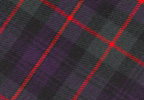|
This clan adopted the name of the ancient Pictish Province of Moray, located in the area surrounding Inverness. In the
mid twelfth century, that area was under the rebellious influence of King MacBeth's descendants. The incumbent, King David
I, sent a Flemish knight to banish the rebels. This Knight was Ollec Freskin who was granted lands and extensive authority
over the Province of Moray. Freskin's family intermarried with the ancient royal family of Moray, thereby gaining hereditary
rights.
Among Freskin's grandsons were: Hugo, First Lord of Sutherland and progenitor of Clan Sutherland; William, Lord of Petty
and ancestor of the Perthshire and lowland branches; Gilbert, Bishop of Caithness and founder of the Sutherland branch;
and Richard, a warrior who also founded the Sutherland branch. The senior branch became the Sutherlands, whereas the
remainder adopted the Murray surname.
William of Petty begot some of the most influential Lords in Sutherland, such as Tullibardine, Abercairney, Bothwell, Ochtertyre,
Mansfield, and Atholl. Many of these titles were acquired by convenient marriages. The Bothwell Murrays were guardians of
Scottish Kings and Regents. Sir Andrew Murray of Bothwell was Sir William Wallace's most influential colleague and general
during the late 13th century.
By the 16th century, there were many Murray families scattered throughout the Kingdom. At that time they banded together
and proclaimed the Tullibardine lineage as chiefs. In 1629 the Tullibardine chief married the Stewart heiress of Atholl and
became the Duke of Atholl. Blair Atholl Castle in Perthshire became the Clan seat, which is still maintained by the present
Chief, the Duke of Atholl. It is interesting to note that the Murray Chief was, for a brief spell, Sovereign of the Isle of
Man in the 18th century, again resulting from a well planned marriage.
While some Murrays in Nova Scotia can trace their origins into Perthshire, the majority hail from the eastern parishes
of Sutherland. As already noted, brothers of the Lord of Sutherland established the name in that area. Gilbert,
Bishop of Caithness, founded the Dornoch Cathedral which stands to this day. The clan spread along the Dornoch Firth and inland
to Rogart and Clyne. Their captain appears to have lived at Abercross in Strath Fleet. For centuries these Murrays fought
gallantly on behalf of the Sutherland Earls, particularly against their ancient enemies, the MacKays.
The Murray migration to Nova Scotia began with the ship "Hector" in 1773, which brought two Sutherland Murray families
to Pictou. After 1800, a steady stream of Murray clansmen left the Northern Highlands to settle in the dark forests of Nova
Scotia. Some came seeking fortune and adventure, while others were ruthlessly evicted from their ancient homeland by their
landlord (after Culloden, and during the Highland Clearances).
Major Murray settlements grew around Barneys River, Middle River, Scotsburn and River John in Pictou County, as well as
Earltown in Colchester County. Their offspring can be found all across Canada and the USA, as well as Australia and South
Africa. Included among their numerous progeny are noted and humble people in all walks of life, including the former Premier
George Murray of Nova Scotia, world renowned singer, Anne Murray, and Rear Admiral Leonard W. Murray of Granton, Pictou County,
the Naval Commander-in-Chief of the Northwest Atlantic during the Second World War.
Clan/Family Histories
- Murray
 According to tradition, a Fleming named Freskin was given land by King David I in the area known as "Moray" (in Gaelic 'Moireabh' which means 'sea-settlement') in the 12th century and his descendants took the name of the area. Over
time it became Murray, the most common "territorial" name in Scotland. One branch became the Earl of Sutherland and another
branch, by marriage, Lords of Bothwell in Lanarkshire. Sir Andrew de Moray was an ally of William Wallace and participated in the Battle of Stirling Bridge in 1297. By further advantageous marriages ( a standard event in those days) the Murray family inherited lands in Abercairney
and Tullibardine in eastern Perthshire and in time the Murrays became the Dukes of Atholl with estates covering 300,000 acres.
A descendant became the Earl of Mansfield who built the magnificent Palace at Scone. The 6th Duke of Atholl founded the Atholl Highlanders who so delighted Queen Victoria that she granted the Duke the right to bear arms, a unique privilege for an individual in the UK. The clan motto "Furth Forth
and Fill the Fetters" dates from 1475 when the Earl of Atholl was sent by King James II to suppress the Lord of the Isles.
According to tradition, a Fleming named Freskin was given land by King David I in the area known as "Moray" (in Gaelic 'Moireabh' which means 'sea-settlement') in the 12th century and his descendants took the name of the area. Over
time it became Murray, the most common "territorial" name in Scotland. One branch became the Earl of Sutherland and another
branch, by marriage, Lords of Bothwell in Lanarkshire. Sir Andrew de Moray was an ally of William Wallace and participated in the Battle of Stirling Bridge in 1297. By further advantageous marriages ( a standard event in those days) the Murray family inherited lands in Abercairney
and Tullibardine in eastern Perthshire and in time the Murrays became the Dukes of Atholl with estates covering 300,000 acres.
A descendant became the Earl of Mansfield who built the magnificent Palace at Scone. The 6th Duke of Atholl founded the Atholl Highlanders who so delighted Queen Victoria that she granted the Duke the right to bear arms, a unique privilege for an individual in the UK. The clan motto "Furth Forth
and Fill the Fetters" dates from 1475 when the Earl of Atholl was sent by King James II to suppress the Lord of the Isles.
Murray was the 12th most frequent surname at the General Register Office in 1995.
The clan motto is "Furth fortune and fill the fetters".
There is a Murray Clan Web Site.
|




